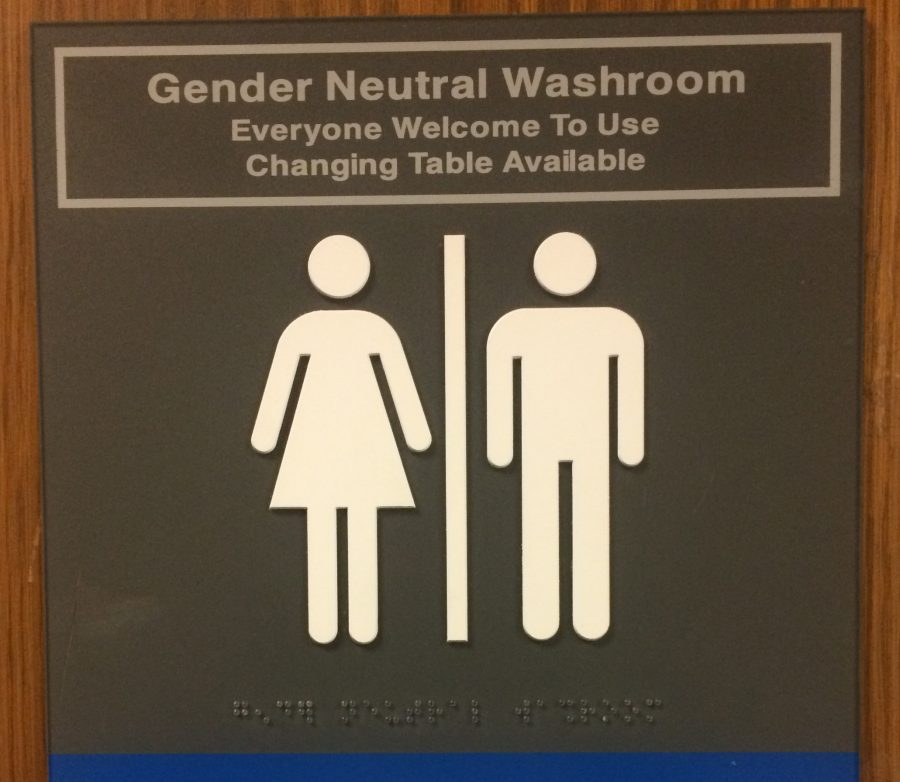EdCC expanding trans access despite Trump
EdCC’s only gender neutral bathroom is located in an alcove attached to the northwest corner of Brier Hall. College administration plans to add more all-gender bathrooms in the near future.
On Feb. 22, the Trump administration revoked Title IX protections for transgender students.
These protections, added during the Obama administration to Title IX of the Education Amendments of 1972, allowed for transgender individuals to be protected from discrimination under any form of education program or activity.
This addition to Title IX was infamous for the inclusion of legal protection while using public restrooms, sparking a nationwide controversy which put a spotlight on the historically overlooked transgender rights movement.
Civil rights groups were outraged, voicing concern over the health and safety of transgender students after the rescinding of this protection.
“This is a mean-spirited attack on hundreds of thousands of students who simply want to be their true selves and be treated with dignity while attending school,” said executive director of the National Center for Transgender Equality, Mara Keisling.
Gov. Jay Inslee of Washington state has been a vocal opponent of the Trump administration, challenging multiple executive orders and federal actions that have taken place over the course of the year, and remained confrontational in regards to the Title IX withdrawal.
“I strongly oppose the Trump Administration’s reversal of federal protection for transgender students,” Inslee said in a statement from Feb. 22.
“Our state’s law, the Anderson-Murray Act, passed in 2006, will remain in place and is unchanged by the new federal guidance. And just last year our state Human Rights Commission did important work to put rules in place that uphold the rights of our transgender students and residents.”
Following the announcement, Edmonds Community College President Dr. Jean Hernandez sent her own public statement out to the school, stating, “I want to assure you that Edmonds Community College will continue to provide an inclusive environment where all students and employees can feel safe and ensured that they have access to the same facilities, classes, and opportunities as others.
“The college fully supports the rights of our transgender students and employees to use whichever bathroom most closely aligns with their gender identity.”
“The president of the college is really committed to these issues,” said Christie A. Santos. Santos is an academic advisor and associate faculty at EdCC with I-CATCH (Innovations in Creating Access to Careers in Healthcare), a program which provides support to low-income families and students.
“When I found out the news about the rescinded Title IX transgender protections, I felt troubled, and really sad. But I felt hopeful when I came to work.”
Santos also is a member of the EdCC Queer Action Team, a group of staff and faculty members who promote LGBTQ+ advocacy on campus through multiple means.
“We’ve prioritized for more all-gender bathrooms on campus,” she said in an interview. One option is a gender-neutral restroom in the Seaview Gym, possibly with showers. This would allow transgender and gender-neutral individuals to have a space where they would feel comfortable not only using the restroom, but changing for sports and exercise.
Edmonds Community College currently has one gender neutral restroom, something that is uncommon for colleges, despite increasing popularity thanks to transgender rights movements.
However, the Queer Action Team is aiming for more, noting that this is not enough to truly help a wide spectrum of individuals who may or may not identify in a traditional sense, or even on a transgender binary of man or woman, if you take into account nonbinary individuals such as gender-fluid or gender-neutral students.
“If we focus on trans-ness as a binary experience, we leave the ‘non-gender identifying individuals’ out.” Santos said.
The Queer Action team aims to have a presence in multiple communities on campus, acknowledging intersectional identities in order to support all students.
Students at EdCC seem comfortable with the idea of sharing restrooms with transgender individuals.
“I think I’d feel totally comfortable with that,” Natalia, an Edmonds CC student, stated in an interview. “Even mixed gender bathrooms don’t bother me too much. I think what would make me uncomfortable is if other people were making a big deal of it.”
Questions regarding safety have arisen from an ever-lingering fear of assault, harassment and persecution from both sides of the civil rights discourse. Cisgendered people (non-transgendered individuals) have predominantly shown concern regarding transgender people using these laws to assault people – primarily women.
However, evidence defending the notion that this concern is worth infringing upon the rights of transgender people nationwide has been deconstructed and de-legitimized over time.
There have been no confirmed or dependable reports of transgender individuals assaulting anyone in public restrooms nationwide.
In 2013, The Daily Mail published an article that a transgender girl at Colorado’s Florence High School had been harassing female students in changing rooms, only for it to be debunked as a flanderization of the real story; a parent had shown concern and called the local news, despite no harassment accounts from students. The story was redacted, but not fast enough; Fox Nation broadcast the original story to the country.
Critics of transgender reform have also used the story of Christopher Hambrook, a predator who had claimed to be transgender in order to assault two women in a shelter back in 2014.
The Toronto Sun published the article, and with it, Hambrook became the single poster boy of anti-transgender rights in regards to restrooms and shelters, despite confirmations that not only was he cisgender, but had a long history of sexual assault previous to the incident.
Toby’s Law, the Ontario version of Washington’s new legislation, was blamed for somehow making this horrible event possible, despite the law not yet being enacted even a month after Chris Hambrook’s crimes.
Fortunately, nearly every state has published repeated statements over the years confirming that laws protecting transgender individuals have not resulted in any rise in crime.
According to William Hoshijo, executive director of the Hawaii Civil Rights Commission (HCRC), Hawaii’s non-discrimination laws passed in 2014 have “not resulted in increase sexual assault or rape in women’s restrooms. The HCRC is not aware of any incidents of sexual assault or rape causally related or attributed to the prohibition against discrimination on the basis of gender identity or expression,” he stated in a Media Matters interview.
Iowa’s 2007 Civil Rights Act and Maine’s 2005 discrimination legislation had the same results, according to Des Moines Police Department spokesman James Halifax.
He quipped in the Media Matters interview, “I doubt that’s gonna encourage the behavior. If the behavior’s there, [sexual predators are] gonna behave as they’re gonna behave no matter what the laws are.”
Maine since 2005, Massachusetts since 1997 and Minneapolis since 1993 have all had spokespeople state that there’s absolutely no factual or even possible relevance between transgender anti-discrimination laws and changes in sexual assault crimes. Nevada, New Mexico, Oregon, Rhode Island and Vermont have similar results.
In fact, statistics show that the opposite is true; it is verifiably much more likely for transgender individuals to be the target for harassment.
The 2011 National Transgender Discrimination Survey (NTDS) found that 78 percent of those who identified as transgender or gender nonconforming in K-12 schooling experienced harassment, many of which included physical assault and sexual violence.
Meanwhile, 90 percent of workers openly identifying as transgender or gender non-conforming experienced harassment, mistreatment or discrimination.
In general, 53 percent of respondents reported verbal attacks made in public accommodations.
From the same National Survey, there are reports of double the unemployment rates (quadruple for trans people of color,) and one-fifth had experienced homelessness due to or relating to their identity. Many (55 percent) also reported being harassed, assaulted or turned away from homeless shelters.
Political analysts expect anti-transgender actions to be expanded upon under the Trump administration. However, states such as Washington continue to oppose sweeping federal lawmaking through state-driven action.






